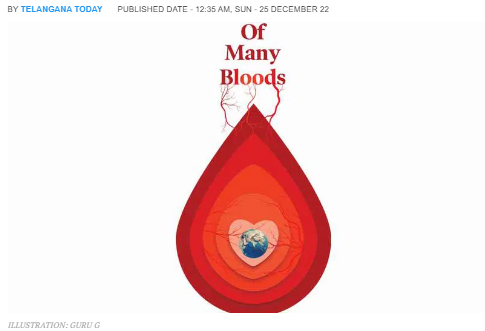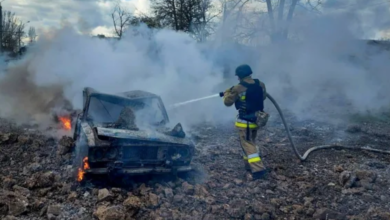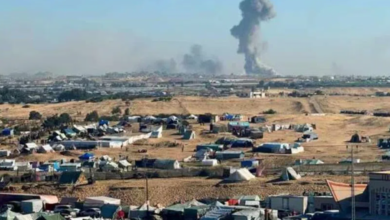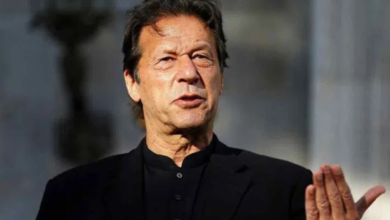Rewind: Of Many Bloods

To rewrite the history of a nation as built by only one community is to pretend there were never mergers, cohabitation, cooperation between/across cultures
By Pramod K Nayar
When the rhetoric of purity subsumes all other rhetoric, blended identities are erased from the histories of nations. When communities clamour for recognition and rights, they are subject to this rhetoric and practices — as the Nazis did with the Jews — of conditional inclusion or worse, exclusion.
By Pramod K Nayar
When the rhetoric of purity subsumes all other rhetoric, blended identities are erased from the histories of nations. When communities clamour for recognition and rights, they are subject to this rhetoric and practices — as the Nazis did with the Jews — of conditional inclusion or worse, exclusion.
When the state moves today to determine the quantum of ‘pure’ blood, to document interfaith, intercaste and other miscegenated relationships, the census merges with scientific racism to divide the society that has lived symbiotically, for centuries. To rewrite the history of a nation as belonging to and built by one community, to claim a monolithic identity for a specific community, is to pretend there were never mergers, cohabitation, cooperation between/across cultures. In the process, the multiple contributions of different communities to nation-building, in forms such as roadways or the postal system, literature or architecture, are steadily written over.
When the historian Shankar Nair in Translating Wisdom, demonstrates how the Mughals in the 16th century, in collaboration with Hindu scholars, translated Yoga texts into Persian, he is pointing to collaborative knowledge-projects that enabled cultural exchange and mutual influence. It is this history of collaboration and cooperation rather than competition that has constituted the greatness of any country.
Projects like The 1619 Project enable us to retain and understand that nations are built by multiple communities in multiple ways over a long period of time. Yet even within these Projects, often unconsciously, certain historically disenfranchised communities are centred and others rendered peripheral. Thus, as Black Lives Matter and Black History month events, with concomitant publishing, arts and other initiatives, rightly foreground their contribution to the making of America, there are pockets of silence and erasure even in these accounts. It is to one such pocket of blended identities that we turn to complicate even the redemptive movements of our time. In order to study such identities, we need to examine the processes of segregation as well.
Scientific Racism
The census operations of the Americas, which began in the 18th century, were attempts to classify in order to segregate. As critics such as James Scott and Bernard Cohn have argued, the ‘sciences’ of arithmetic, counting and classification were tools of empire and control. America was no exception when it came to race.
| The ‘sciences’ of counting and classification of peoples were tools of imperial control |
The 1850 census introduced the term ‘mulatto’ to indicate persons of mixed parentage. After much debate, the instructions to census takers read:
Under heading 5 entitled “Color”, insert in all cases, when the slave is black, the letter B; when he or she is mulatto, insert M. The color of all slaves should be noted.
(US Bureau of the Census, Two-hundred Years of Census Taking Population and Housing Questions, 1790-1990, 1989)
By the late 19th century, census takers were instructed to count ‘quadroons, octoroons…and all persons having any perceptible trace of African blood’ (quadroons were one-quarter black in ancestry, octoroons were one-eighth black). The category mulatto was dropped only in 1920. African ancestry was determined by hypodescent: racial identity based on any known black ancestry. Native American ancestry was determined by hyperdescent, which required a minimum quantum of Native American blood.
The Spanish introduced the ‘measurement’ of blood as a method of racial identity-making. They believed there were three pure blood types: European, African and Native American. The Spanish then proceeded to create racial types based on maternal descent and the quantum of European blood. There appeared, then, the mestizo (Native American Spanish), the mulatto (African Spanish), zambo (African Native American). They created categories such as cuarteron (three-quarters Spanish, one quarter African), cuarteado (one half Spanish, one quarter African, one quarter Native American), cambujo (three quarters Native American, one quarter African) and cambur (one half African, one quarter Spanish, one quarter Native American).
Prior to 1890, only those Native Americans deemed to be ‘civilised’ enough to own property and who paid taxes were listed in the census. It was only in 1924 that all American Native Americans of mixed blood were termed ‘Native Americans’.
| The census in history has inevitably instantiated a data racism |
The census was data racism, determining not just citizenship but also taxation and property rights. Enumeration was preliminary to segregation and disenfranchisement, and the emphasis on blood quantum bestowed a certain scientific legitimacy to racialisation processes. And yet, within these spaces of racialised identity-making, there were complications of exchanges, co-optation and adaptation across the colour line, once again demonstrating how cultural boundaries may be policed but not always controlled. Co-optation across the colour line, over many generations of African and Native Americans, often took the form of soldiery.
Buffalo Soldiers and the Braves
The Native Americans labelled the African soldiers ‘Buffalo Soldiers’, making comparisons between the colour of the African’s skin and the bison, because the Native Americans admired the tenacity and strength of the bison and, therefore, as Herman Viola, curator, Smithsonian Museum of Natural History, notes, the term was not necessarily derogatory. However, Viola notes, the Africans distinguished themselves in some of the fiercest battles waged to suppress the Native Americans. In Viola’s words, ‘one abused minority helped suppress another’.
After the Civil War, the Buffalo Soldiers, some of whom who had Native American blood, intermarried. Native American tribes welcomed these soldiers and often boasted of having a Buffalo Soldier in their ancestry. Photographic records of such marriages exist from the early 20th century. Thus, these photographs highlight the familial and affiliative relationships across races.
The reasons for these shifting attitudes were simple: soldiers were admired, whether African or Native American. The Native Americans, often called the ‘Braves’, admired valour above all else. The involvement of Native Americans in America’s wars speaks of the complicated history of racism, assimilation and blended identity.
During the American Revolution, Native American loyalty was divided between England and the colonies. During the war of 1812, this division was between England and the United States. In the Civil War, it was between the North and South. This inclusion of Native Americans in every war, notes Viola in his earlier work, Warriors in Uniform, was a fraught exercise because neither the English nor the Americans wished to include Native Americans for the simple reason that the Native Americans did not fight in accordance with the codes of ‘civilised’ war!
Despite this, more Native Americans did take part in the earliest wars: there were 5,000 Native Americans in George Washington’s army. Some tribes, however, did side with the British as well, and after the, war paid the price (Tecumseh of the Shawnees famously fought against the United States in the 1812 war). Numerous lithographs of such soldiers exist from these wars.
Subsequently, Native Americans were a part of the American army in the World Wars, and much later too, in Afghanistan, Lebanon and Iraq. Viola notes in his Warrior Spirit: The Story of Native American Heroism and Patriotism (2022):
The wars enabled the Native Americans to demonstrate their courage and fighting abilities… A sad consequence for Native American soldiers striving to live up to the unrealistic expectations of their supposed “warrior skills” is that they suffered more casualties than their white comrades in combat. For example, during World War I an estimated 5 percent of the Native American were killed or wounded, as compared to a 1 percent casualty rate for the entire American Expeditionary Force, which suffered a total of 50,280 killed and 95,786 wounded.
In short, war and its brutalities became a means, conscious or unconscious, of establishing their identity as the Braves, for the Native Americans, and of negotiating their relationships with white America. It also renegotiated their identities vis-à-vis the African Americans. Two victims of racism both contributed in similar but not identical ways to the shaping of America.
Blended Identities
Through the 18th and 19th centuries, Africans and Native Americans were pitted against each other by the whites. The Jim Crow laws did not distinguish between African Americans and Native Americans, seeing both as ‘coloured’. The southern Native Americans enslaved Africans, seeing them as outsiders on par with the white Europeans, in ‘their’ land.
Critics note that by the end of the 18th century, the southern Native Americans had adopted the attitudes of the whites: treating the Africans as primitive and a lower race. The work of Helen Rowntree (famous for her book on Pochahontas, 1990) records anti-black racism among the Native Americans of the Virginia and southern United States. It has been argued that such an anti-black racism emerged within the Native American context when the latter sought to mimic Anglo-American (white) attitudes. Laws prevented the intermarriage of whites with Africans or Native Americans, even as the Native Americans, on their own, proscribed marriage with Africans but not with the whites. Thus, the Native Americans seeking to preserve their own cultural and racial identity were less comfortable mixing with the Africans than with the whites. Conversely, the African Americans were trying to merge into the American mainstream, but the Native Americans wished to retain their distinctiveness. And yet, identities, like families, blended across the colour line.
Photographic and land allotment records have been unearthed in the American context showing Blacks in Native American costumes, even in family portraits. Researchers like Angela Walton-Raji have painstakingly identified genealogies of mixed-race, or ‘blended’, families through an examination of such records but also interviews taken under oath. Even today the Dawes Commission (1899-1914) and the famous Dawes Rolls constitute the best known records of Native American families, and show numerous mixed-blood ones. Census records of Cherokee Nation, and even the officially rejected records of the Mississippi Choctaws and others are indispensable for genealogical purposes — and all demonstrated blended identities.
The family portrait, as the critic Marianne Hirsch has persuasively argued, signals the centrality of the family as a unit. These photographs can also serve as modes of transmission of memory to the next generation — what Hirsch refers to as the ‘the familial transfer of embodied experience to the next generation’. These photographic records document both, vertical connections across generations but also horizontal connections across their contemporaries. This is what makes the photographic record of Black families with members in Indigenous costume so significant, for they capture not only the Black family as a unit but also their connections and exchanges, of many types and layers, with the Indigenous populations of the Americas. Earnestine Jenkins, a professor of art history, in a recent essay on such photographs calls this record a ‘history of entanglements’:
The photographic image likely references the history of the Native American Freedmen once enslaved by the Choctaw, Cherokee, Chickasaw, Creek, and Seminole peoples. During the 1830s, Black people were forced to evacuate the Southeast, accompanying Native American slaveholders on the Trail of Tears to Native American territory out West … Upon arrival, Indigenous peoples rebuilt their communities; they established their nations anew with Black enslaved labour, crushed slave resistance with violence, and sided with the Confederacy during the Civil War.
Gabrielle Tayac in her Foreword to the Smithsonian’s National Museum of the American Native American’s volume, IndiVisible: African-Native American Lives in the Americas (2009) describes such entanglements succinctly as
An invisible experience with an indivisible reality found in the illumination of centuries-long relationships between African Americans and Native Americans.
| A nation cannot be said to emerge from the efforts of one single community or group, because all groups, at some point, have forsaken purity for the pleasures, or contingent necessity, of mixing |
As the century and its states hurtle towards a repetition of the rhetoric of purity, history shows us that even nations who have practised severe attempts at separating blood types and segregating peoples have given in, eventually, to the recognition that, pure or impure, many races and tribes built their nation.
A nation cannot be said to emerge from the efforts of one single community or group, because all groups, at some point have forsaken purity for the pleasures, or contingent necessity, of mixing. Histories show separation, discrimination, survival and reconstruction (to use the term most associated with post-Civil War America) of tribes and communities. In the hoary tradition of massacres and segregation of pure lines, individuals fall. It is important to mind the words of Pulitzer-winner poet Jericho Brown who ends his ‘The Tradition’ with an inventory of such individuals lost to the racialised battles over identity:
Men like me and my brothers filmed what we
Planted for proof we existed before
Too late, sped the video to see blossoms
Brought in seconds, colors you expect in poems
Where the world ends, everything cut down.
John Crawford. Eric Garner. Mike Brown.
In the battle for purity, the Emmett Tills and the Jews are individual and collective victims.
(The author is Professor of English and UNESCO Chair in Vulnerability Studies at the University of Hyderabad, and a Fellow of the Royal Historical Society)







